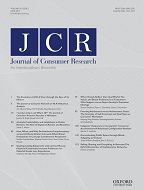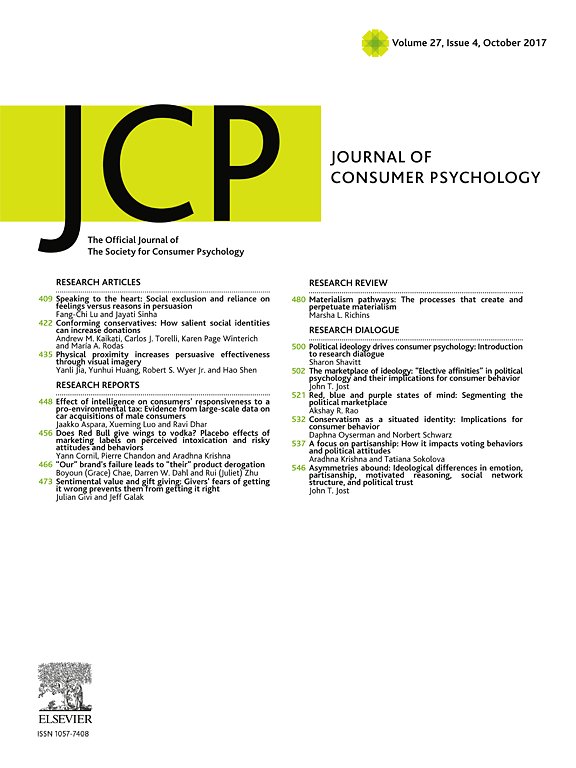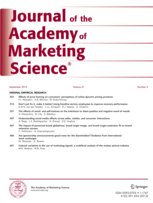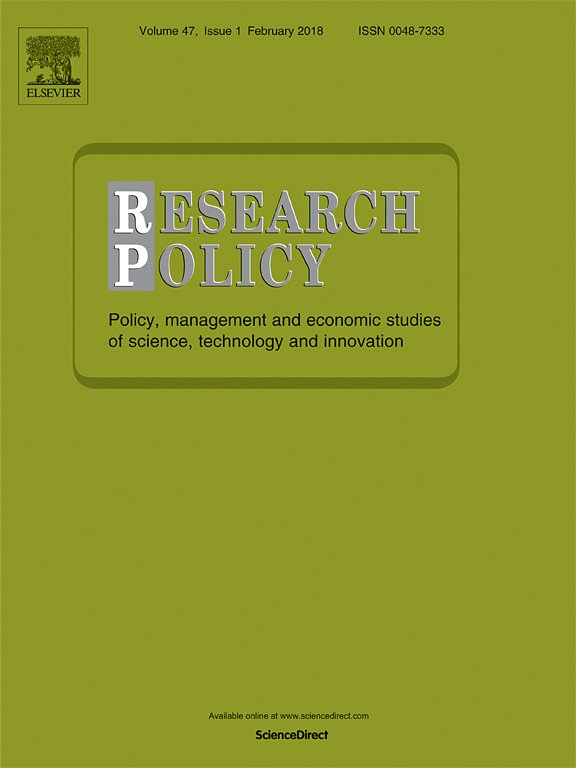TOP PUBLICATIONS
Below you find a list of our top publications. For a complete list of publication activities, please visit the research database.

Streicher, M. C., Zachary Estes, and Oliver B. Büttner (2021), "Exploratory Shopping: Attention Affects In-store Exploration and Unplanned Purchasing“. Journal of Consumer Research.
A fundamental function of retailing is to bring products into the view of shoppers, because viewing products can activate forgotten or new needs. Retailers thus employ various strategies to entice shoppers to explore the product assortment and store environment, in the hopes of stimulating unplanned purchasing. This article investigates consumers’ breadth of attention as a mechanism of such in-store exploration and hence of unplanned purchasing. Specifically, attentional breadth is the focus that is directed to a wider or more limited area in processing visual scenes. Across several lab and field experiments, the authors show that shoppers’ attentional breadth activates an exploratory mindset that stimulates visual and physical exploration of shopping environments, ultimately affecting their product choices and unplanned purchasing. The results also show that more impulsive buyers are more susceptible to these effects. The present article thus complements and constrains prior theorizing on mindset theory, attention, store exploration, and unplanned purchasing, all of which are of practical importance to both retailers and consumers.

Estes, Z., and Streicher, M. C. (2021). Getting a Handle on Sales: Shopping Carts Affect Purchasing by Activating Arm Muscles. Journal of Marketing.
This research demonstrates that the physical properties of shopping carts influence purchasing and spending. Prior research on ergonomics indicates that standard shopping carts, which are pushed via a horizontal handlebar, are likely to activate arm extensor muscles. Prior research on arm muscle activation, in turn, suggests that arm extensor activation may elicit less purchasing than arm flexor activation. The authors thus deduce that standard shopping carts may be suboptimal for stimulating purchases. The authors predicted that shopping carts with parallel handles (such as on a wheelbarrow or “walker”) would instead activate the flexor muscles and thus increase purchasing. An electromyography study revealed that both horizontal and vertical handles more strongly activate the extensor muscles of the upper arm (triceps), whereas parallel handles more strongly activate the flexor muscles (biceps). In a field experiment, parallel-handle shopping carts significantly and substantially increased sales across a broad range of categories, including both vice and virtue products. Finally, in a simulated shopping experiment, parallel handles increased purchasing and spending beyond both horizontal and vertical handles. These results were not attributable to the novelty of the shopping cart itself, participants’ mood, or purely ergonomic factors.
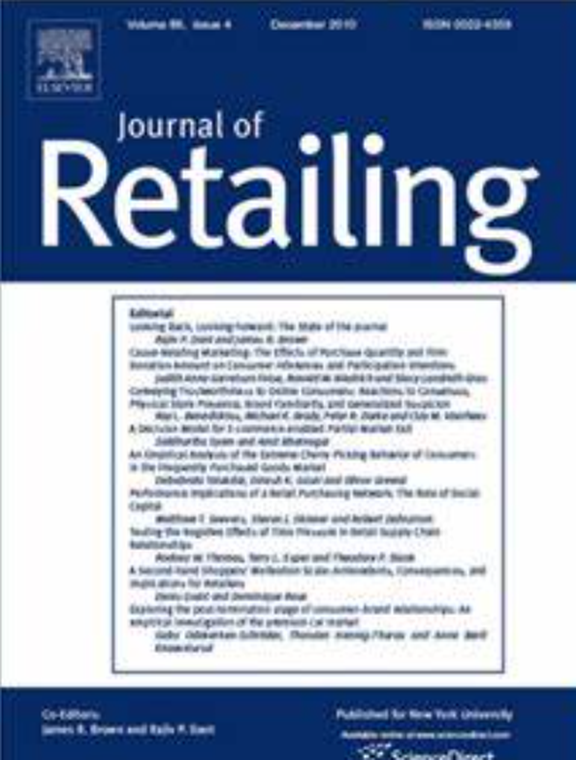
Koll, Oliver; Plank, Andreas (2022 online first): Do Shoppers Choose the Same Brand on the Next Trip When Facing the Same Context? An Empirical Investigation in FMCG Retailing.Journal of Retailing
The most basic manifestation of brand loyalty is repurchasing – making the same choice on the next category occasion. This study tests to which extent the stability of contextual cues across purchase occasions affects repurchasing. We investigate these effects by analyzing a total of 1.6 million brand choice pairs (i.e., two consecutive choices) of 20,587 German and 23,036 British shoppers in three FMCG categories. We find that stable contextual cues (same retailer, basket size or weekday as on previous occasions) further repurchasing whereas unstable contextual cues (different retailer, basket size or weekday as on previous occasions, a promotion chosen on one of the occasions or a different assortment size) hinder repurchasing. Furthermore, our results stress the importance of inertia and the power of private labels to foster repurchasing. This study provides generalizable insights regarding trip-to-trip stability in shoppers’ choices, proposes a metric to benchmark brand performance across multiple retail outlets, and pinpoints opportunities for manufacturer-retailer cooperation in order to nurture repurchasing.

Wieser, Verena E., Luedicke, Marius K., and Andrea Hemetsberger (2021), “Charismatic Entrainment: How Brand Leaders and Consumers Co-Create Charismatic Authority in the Marketplace,” Journal of Consumer Research, 48 (4), 731–51
How do CEOs, entrepreneurs, managers, celebrity bloggers, and other brand leaders acquire charismatic authority in the marketplace? Grounded in a multi-perspective, in-depth case study of the charismatic CEO of an Austrian shoe manufacturer, this article introduces a sociocultural mechanism called charismatic entrainment. Charismatic entrainment involves brand leaders staging charismatic authority by promoting polarized worldviews and taking personal risks to demonstrate their ability to lead social change. It further involves consumer-followers publicly validating and consumer-critics challenging brand leaders’ claims to charismatic authority, encouraging further entrainment via their support, but also their criticism. Brand leaders, consumer-followers, and consumer-critics draw on social media, marketplace sentiments, and brand manifestations as entrainment resources to more effectively endow brand leaders with charismatic authority in the marketplace. The article contributes a market-based, multi-stakeholder—versus an organizational, leader-centric—theory of charisma co-creation to the literature on charismatic authority. It also adds to theories of iconic branding, risk consumption, and societal morality plays, sensitizing readers to the constructive but also destructive potential of market-based charisma co-creation.
Schroll, Roland, Benedikt Schnurr, and Dhruv Grewal (forthcoming), “Humanizing Products with Handwritten Typefaces,” Journal of Consumer Research, forthcoming.
The loss of a sense of humanness that stems from increasing mechanization, automation, and digitization gives firms an impetus to develop effective ways to humanize products. On the basis of knowledge activation theory, this article systematically investigates a novel humanization approach: the use of typefaces that appear to be handwritten. Across several laboratory and field studies, the authors provide evidence of the positive effect of handwritten typefaces, reveal the mechanisms that lead to these outcomes, and outline some boundary conditions. Specifically, the results show that handwritten typefaces create perceptions of human presence, which lead to more favorable product evaluations (and behavior) by enhancing the emotional attachment between the consumer and the product. However, these effects are mitigated for brands to which consumers already feel a sense of attachment. Finally, the effects reverse when the products are functionally positioned or functional in nature. The present article thus extends understanding of humanization processes and provides guidelines for how and when brands should use handwritten typefaces.
Plank, Andreas (2016). The hidden risk in user-generated content: An investigation of ski tourers' revealed risk-taking behavior on an online outdoor sports platform. Tourism Management, 55 (August), 289-296.
This paper investigates risk-taking behavior in the context of an online outdoor sports platform. Analyzing a unique behavioral dataset of 6242 ski tours completed over a time period of eight winter seasons, this paper shows that the accuracy of user-generated content on ski tours is limited and that more than one third of ski tours accessible on the respective online platform was relatively dangerous on the particular days according to a common avalanche risk assessment method. The quantitative analysis furthermore reveals that at avalanche danger level “considerable” more than sixty percent of ski tours were relatively dangerous. Overall, this paper provides novel insights into risks that come with usergenerated content in the adventure tourism and adventure recreation domain and derives important implications for online platform users, online platform providers, public institutions, and tourism destinations.
Streicher, M. C., & Estes, Z. (2016). Multisensory interaction in product choice: Grasping a product affects choice of other seen products.Journal of Consumer Psychology, 26(4), 558-565.
Consumers often touch products before reaching purchase decisions, and indeed touch improves evaluations of the given product. The present research investigates how touching a given product influences perception and choice of other seen products. We show that grasping a source product increases the visual fluency of a haptically similar product, thereby increasing the likelihood of choosing that product, but not the willingness to pay for it (Study 1). We also show that visually crowded rather than sparse product displays increase the effect of touch on choosing other haptically similar products, and that individuals’ instrumental need for touch further modulates this effect (Study 2). Our results suggest that by manipulating or mimicking the haptic features (e.g., shape and size) of objects that consumers grasp while shopping, marketers can develop packaging that facilitates consumers’ visual processing of their products, thereby increasing choice of those products.
Streicher, M. C. and Estes, Z. (2015), Shopping to and fro: Ideomotor Compatibility of Arm Postures and Product Choice, Journal of Consumer Psychology, 26(3), 325-336.
Consumption often requires flexing arms toward the body and merely inducing such activities has been shown to influence consumption. In three studies we show that the consumption effects from lateral arm movements arise from the fit between cognitions and motor activity. When a shopping situation conceptualizes product acquisition as movement away from the body the effects from priming arm flexion and extension are reversed. The findings prefer an ideomotor compatibility account rather than suggesting hardwired and unmalleable association between arm posture and consumption. The implications of these results for ideomotor research and management practice are discussed.
Bas Hillebrand, Paul Driessen, Oliver Koll (2015), Stakeholder Marketing: Theoretical Foundations and Required Capabilities, Journal of the Academy of Marketing Science, 43 (4), 411-428.
This conceptual paper argues that the marketing discipline should move away from its rather restrictive focus on customers toward a view of marketing that acknowledges the interrelatedness of stakeholders. Building on multiplicity theory, this paper presents stakeholder marketing as a revised perspective on marketing that views stakeholder networks as continuous instead of discrete multiplicities. This revised perspective offers a better understanding of stakeholder networks where (1) value exchange has become complex rather than dyadic, (2) tension between stakeholder interests has become explicit rather than implicit, and (3) control over marketing activities has become dispersed rather than centralized. The paper conceptualizes capabilities required by firms for dealing with each of these three transitions: systems thinking, paradoxical thinking, and democratic thinking. The paper discusses implications for firm performance, marketing theory, empirical research, and marketing practice and argues that embracing stakeholder marketing helps to reclaim territory for marketing in academia and business.
Füller, J., Schroll, R., & von Hippel, E. (2013), User generated brands and their contribution to the diffusion of user innovations, Research Policy, 42(6-7), 1197-1209.
It has been argued that users can create innovations and also diffuse them peer-to-peer independent of support or involvement by producers: that “user-only” innovation systems can exist. It is known that users can be incented to innovate via benefits from in-house use. But users’ incentives to invest in diffusion are much less clear: benefits that others might obtain from their innovation can be largely or entirely an externality for user innovators. Of course, effective distribution of information products can be done near-costlessly via posting downloadable content – for example, software – on the Internet. However, potential adopters must still learn about the product and trust its qualities. In producer systems, this aspect of diffusion is heavily supported via the creation of trusted brands. It has been shown that brands help to increase awareness, to communicate a product's benefits, and to reduce perceived risks of adoption. The development of brands by producers is traditionally seen as a very costly exercise – unlikely to be thought of as worthwhile by users who expect little or no benefits from the diffusion of their innovations to others. In this paper, we explore the creation of a strong and trusted brand by the Apache software community – and find it was created costlessly, as a side effect of normal community functioning. We think the costlesscreation of strong brands is an option that is generally available to user innovation communities. It supports, we propose, the existence of robust, user-only innovation systems by helping to solve the problem of low-cost diffusion of trusted user-developed innovations.
Hemetsberger, Andrea and Christian Reinhardt (2009), "Collective Development in Open-Source Communities: An Activity Theoretical Perspective on Successful Online Collaboration," Organization Studies, Vol. 30, 9, 987-1008.
Online collaboration is often organized without strong predetermined rules or central authority, which is why coordination and ways of organizing cooperation become crucial elements of collaboration. This article investigates how online projects can overcome problems of dispersed work, solve inherent contradictions and utilize tensions in the activity system to develop collaborative artefacts and practices. Empirical evidence is based on a detailed observation of a successful open-source project — the K Desktop Environment (KDE). Our findings show that successful collaboration is based on coat-tailing systems. Coat-tailing means to inextricably bind together individual action and collective activity through careful design of complexes of technological, mental and cultural artefacts.

